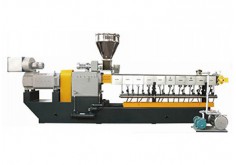Copyright © Shanghai Omega Machinery Co., Ltd. All rights reserved.
What is the process of twin screw extruder?
Aug 18,2023
The twin screw extruder is a sophisticated piece of equipment designed for the compounding, mixing, and shaping of polymer materials. Comprising two interlocking screws encased within a barrel, this machine employs controlled movement and precise heat application to process raw materials into finely crafted end products.
The Extrusion Process
Feeding: Raw materials, often in the form of plastic resin pellets, are introduced into the extruder through a designated feeding mechanism. This initial step sets the stage for subsequent stages of the process.
Melting and Mixing: As the raw materials progress along the barrel, they are subjected to increasing temperatures and mechanical shear forces. The twin screws rotate in a coordinated manner, imparting intense mixing and kneading action to the materials. This results in the gradual melting and homogenization of the polymer.
Additive Introduction: At this stage, additives such as colorants, stabilizers, and fillers can be introduced into the molten polymer. The twin screw extruder's exceptional mixing capabilities ensure uniform distribution of additives, contributing to the desired properties of the final product.Pressurization and Transition: The molten polymer blend is pushed forward through the extruder barrel, undergoing pressurization. This pressurized transition is crucial for achieving consistent melt properties and facilitating subsequent shaping.
Shaping and Forming: Upon reaching the die, the molten polymer blend is forced through a specially designed opening that imparts the desired shape to the material. This could range from simple profiles to intricate designs, depending on the die's specifications.
Cooling and Solidification: As the newly shaped polymer emerges from the die, it enters a cooling environment. This rapid cooling solidifies the polymer into its final form, locking in the properties achieved during the extrusion process.
Prev News Next News
- Information
- Why do large, dull and unreflective bubbles appear on the surface of the special profiles? How can this problem be solved?
- What causes the uneven surface and poor gloss of the sheet during the sheet extrusion process? How can it be solved?
- Why does the cooling process for profile extrusion become unbalanced?
- What countermeasures can be taken to improve the dimensional and positional accuracy of profiles during the profile production process?
- How should profile molds be cleaned and maintained?
- What are the corresponding solutions to the phenomenon of grooves and pits on the surface of profiles?
- How should the raw materials be selected in the formula for PVC surface skin core layer microcellular foamed extruded profiles?
- How should the production process of biaxially oriented polyethylene terephthalate (BOPET) film be controlled?
- How should the longitudinal and transverse stretching be controlled when producing biaxially oriented films by the flat film method?
- How should the counter-rotating conical twin-screw extruder be operated for no-load test run?
- Contact Us

-
Shanghai Omega Machinery Co., Ltd.
Add.: No.168 Hualian Road, Putuo District, Shanghai City
Contact: Nina
Tel.: +86-021-69921527
Mobile: +86-15021464410
Fax: +86-021-69921567
E-mail: omegajessica@163.com;965425705@qq.com
WeChat No.: 1131449532
Whatsapp: +86 159 0054 6558

-
